If you plan to visit Colombia, you must set aside three or four days to take in the vibrant Andes capital city of Bogotá and around. Here below, is what to me, is the best of Bogotá in 3 days. It is a tour designed with Bogotá as your base and could take you out of the city as well.
The City is located high on the Eastern Cordillera of the Andes Mountains, at an altitude of 8,660 feet above mean sea level. As the bustling capital of Colombia, Bogotá is home to over 8 million residents, with a daytime population that could soar to almost 10 million. The metropolitan population is over 12 Million. It is a large city by any standard.
The Culture of Bogotá and Colombia
Colombians – A People of Warmth and Curiosity
A word about the people before I proceed any further. Colombians are known for their friendliness and curiosity towards foreigners. Despite the language barrier, they treat visitors with genuine warmth and respect. Be prepared for close personal interactions. The Colombian concept of personal space may be a lot smaller than yours! Embrace their hospitality, and you’ll experience the true charm of Colombian culture.
City Layout – Navigating Bogotá
The city’s grid pattern simplifies navigation. The Carreras (avenues) run north to south and Calles (streets) run east to west. In spite of traffic challenges, Bogotá offers captivating experiences and unforgettable sights. They will inspire your curiosity.
Explore The Best of Bogotá And Beyond – a Three-Day Itinerary
What can you do in Bogotá for 3 days? Let me recommend a 3-day, 4-night Bogotá itinerary. Everything in this proposition is do-it-yourself. Following this itinerary you can take things at your own pace. Explore the City and beyond, to view everything from a very personal perspective. A little bit of reading on the Internet will, of course, help. If you would like to save some time, and take a guided tour read about it here. We can also help with other tours in Bogotá and other Colombian cities. Tell us what you would like to do and we can help make your Andean visit memorable. Welcome to my Bogotá!
If you wish to take photographs as you walk through central Bogotá, click here to read about my tips and recommendations for secure photography in Bogotá.
Day 1: Start Your 3-Day Bogotá Itinerary With A Walking Tour
A Self-Guided Walking Tour of the Capital City
Delve into Bogotá’s rich history and culture with a DIY walking tour, starting at the world-renowned Gold Museum (closed on Mondays and crowded on Sundays). Visit this glistening attraction on a weekday morning to avoid crowds. The entrance fee is only about US $1.20 per adult. Adults over 60 and children below 12 years of age have free access. You can rent an Audio Guide for about US $1.80. However, as the internal signage is quite good, you may not need the Audio Guide. You will see descriptions in both English and Spanish displayed next to each exhibit. The Museum is open from 9.00 am to 6:00 pm and on Sundays from 10:00 am to 4:00 pm.
The Museo del Oro: Explore the Colombian Golden Heritage
The Banco de la República (the Colombian Central Bank) owns the Museo del Oro, lock, stock and barrel. It is considered a patrimony of the Nation. The museum has a collection of over 55,000 gold pieces. What is on display, is only a fraction (about 6000 pieces), of the museum’s glittering gold artefacts. There are pieces that date back nearly 2,000 years.
Everything that Glitters is Gold!
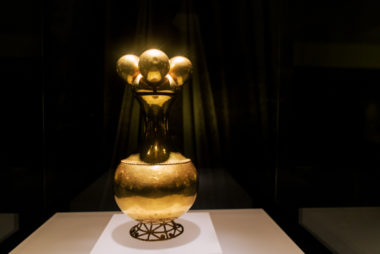
The glimmer of the intricate pre-Colombian displays will mesmerize you. Here, everything that glitters is gold! Remember that the Spanish colonials were after the gold and the legend of El Dorado in South America? The legend originates in Colombia. They even tried to drain some deep natural lakes in their quest for the yellow metal. The Spanish colonials did not find much of the gold in Colombia because it was buried with the pre-Colombian dead.
The gold artefacts discovered in Colombia, and the local tribal culture that used so much gold, have given El Dorado, Bogota’s international airport, its name. El Dorado translates to, ‘the Golden One‘ – referring to tribal chiefs who were covered in gold dust for their various ceremonies.
Admire the displays of the almost-melted-down Poporo Quimbaya, a national symbol, and do not miss the gold Muisca raft. The Museum is a must-see attraction in Bogotá.
Dedicate approximately 2 to 3 hours to fully appreciate the Gold Museum’s mesmerising exhibits, setting the tone for a truly memorable experience in Colombia’s capital city.
Every Walking Tour Should Take You to Plaza Bolívar – The Heart of the City
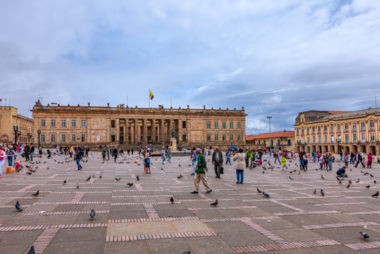
After experiencing the enchantment of the Gold Museum, on leaving the building, walk across the small park in front. The church across the road is Iglesia de San Francisco, the oldest church in Bogotá (along with Santa Clara). The road in front of you is Carrera 7. Turn left. You will have the church on your right. A brief, brisk 10 to 15-minute stroll covering about 700 meters (5 blocks), will lead you to Plaza Bolívar, Bogotá’s principal square. It is located in La Candelaria.
Capitolio Nacional, Palacio Liévano, and Catedral Primada: Seats of Power
In Plaza Bolívar, you’ll find the Colombian Parliament, referred to locally as El Capitolio Nacional. On the opposite southern side of the square, is the third iteration of the Country’s Supreme Court. It is the Palacio de Justicia, in Spanish. The building proudly bears defiant resilience to its existence. It has survived two prior devastations. The infamous M-19 guerrilla group was responsible for the last one.
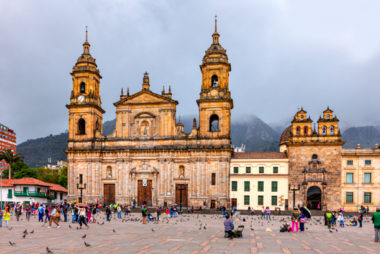
On the western side, you will see Palacio Liévano, the Mayor’s office. On the opposite eastern side, is the majestic Catedral Primada, the seat of the Roman Catholic Archbishop of Colombia. Feel free to enter the cathedral if it is open. Photography is allowed inside the church, but one needs to respect the worshippers and avoid a flash. Don’t miss the centuries-old Capilla del Sagrario (built in 1660), to its right (as viewed from the square), and the Cardinal’s Palace and office.
La Casa del Florero – A Symbol of Independence
Located in the northeast corner of the square, is the La Casa del Florero. It is now a museum. This former residence is where the cry for independence from Spain first rang out. An incident involving a flower vase preceded the cry for independence, hence the name Casa del Florero or translated, the House of the Vase.
The museum is open from 9:00 am to 5:00 pm, Tuesday to Sunday. It is closed on Mondays and holidays. Adult visitors from other countries must pay a $10.00 entry fee, with an additional $1.00 security donation. Entry is free for visitors over the age of 60 years. They must usually provide a document (National ID or Driving License) as proof of age.
La Candelaria – A Tapestry of History and Culture
Continue with your Bogotá itinerary. Take the road (Calle 10) between the Parliament and the Cardinal’s Palace. Walking uphill will lead you to the centre of historic Bogotá – La Candelaria. Founded over 480 years ago, the area retains its historic charm. Explore the many narrow streets where well-maintained old colonial architecture is visible all around you. Some of the old residences are now small museums and allow visitors to go inside. You can see for yourself what residences were like, a few centuries ago.
While walking through La Candelaria, like in any busy city anywhere in the world, one needs to take care and be aware of one’s surroundings.
Teatro Colón – The 19th Century Opera
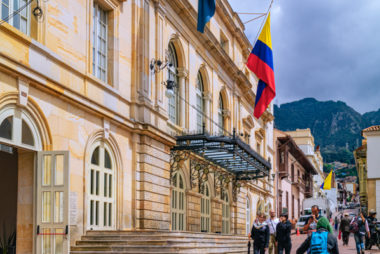
On Calle 10, pause to admire Teatro Colón, Bogotá’s elegant opera house. When open to the public, you can step inside for a small fee and admire the interior. It has interesting Guided tours in Spanish (when available), and provides a fascinating glimpse into the Theatre’s rich history. Created in the neoclassical style, the interior was designed in the traditional horseshoe shape. It is modelled on the Palais Garnier in Paris. It however is less than half the size of the famous Parisian Opera. Teatro Colón was inaugurated in 1892
Palacio San Carlos – The Past And A Window!
Directly across from Teatro Colón, you’ll find the historic Palacio San Carlos, once home to Simón Bolívar. It was here, warned by his mistress Manuela Sáenz Aizpuru, that he made a daring escape from an assassination attempt, through a palace window. He escaped with soap still on his body, wearing nothing. From then on, Manuela was called the ‘Liberator of the Liberator.’ The window on Calle 10, marked with a small plaque, serves as a reminder of this dramatic event.
The palace now houses the Ministry of External Affairs. It is unfortunately closed to the public, but its storied past remains etched within its walls.
Chorro de Quevedo – Where the Story of Bogotá Began
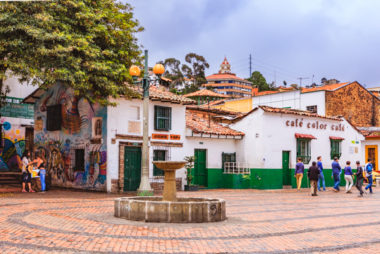
After visiting Teatro Colón, walk approximately 650 meters (click URL for directions), in a northeasterly direction to reach the Chorro de Quevedo.
You may wish to consult Google Maps on your mobile phone to guide you through the streets of La Candelaria. Please, however, exercise caution when using your phone on the streets and roads. I would advise that you use your phone as you sip a cup of delicious Colombian coffee in one of the many Cafes.
It is from this small square that the story of Bogotá began over 480 years ago. Fr. Quevedo was responsible for the original installation of the small fountain on the Square. The Square takes its name from the fountain and the priest. Once again you will have History all around you.
It is said that the Zipa (local tribal chief) of the Muisca tribe regularly surveyed the Savana of Bogotá from this area before it was built up by Gonzalo Jiménez de Quesada and the Spanish Conquistadors. Bogotá was founded by de Quesada on 6th August 1538.
Today, you will be surrounded by street art, graffiti, restaurants and cafes on the Square. It may be a good idea to have a meal at the square.
Calle del Embudo – An Old, Fascinating Narrow Street
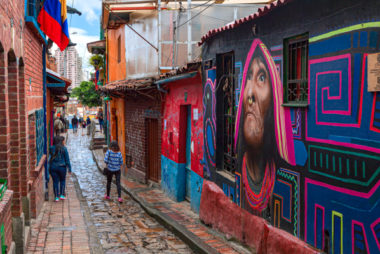
After lunch, access the narrow end of the popular Calle Del Embudo (Funnel Street), from Chorro de Quevedo through the tall gate at one corner of the Square. The street takes its name from its odd shape: narrow at one end and comparatively, much broader at the other – shaped like a funnel. You can easily imagine the times when people rode on horseback or used horse-drawn carriages. It is Carrera 2 and is one of my favourite streets in La Candelaria.
The cobble-stoned alleyway is one of the oldest in the City. View the colourful graffiti and street art on the short passage between Calle 12B and 12C. It is one that visitors to the City must have on their itinerary. While visiting this part of La Candelaria, look upwards as well. You will spot odd and interesting sculptures. There are such installations in other parts of the area as well.
The Streets of La Candelaria – A Journey Back in Time
Explore other streets in La Candelaria, each with a fascinating story of its own and more street art. After you have had your fill of the area, you’d probably have done enough for the day. It is time to return to your hotel and rest your weary legs. Request your taxi using the mobile app ensuring you are on one of the streets that allow access to cars.
If you wish, you can handle all of the above as a guided tour, using this link.
Day 2: Monserrate – High up on the Andes Mountains
On Day 2 of your 3-day Bogotá itinerary, experience the amazing views and spiritual serenity on a breathtaking journey to the Andean peak of Monserrate, 10,341 feet above mean sea level.
Rising Above the City – The Cable Car to Monserrate
Take a taxi from your hotel to the cable car station at the base of Monserrate to obtain your ticket for your upward journey. The Andean peak soars 1,500 feet above Bogotá. Tip: position yourself by the station-side window of the cable car; you will be rewarded with good views of the city as the car moves up. Trekking uphill is not recommended for safety reasons. Try to avoid going up on Sundays: Monserrate is crowded on that day.
Panoramic Splendor – Views From The Top
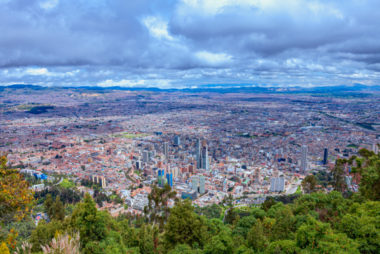
At the top, standing at over 10,300 feet above mean sea level, take in the expansive panorama of Bogotá City. The flat Altiplano Cundiboyacense, a former sea, stretches out before you. Admire the vastness of the high plateau which was once the sea bed, and today allows for the seemingly limitless expansion of the capital city.
If it is cloudy upon arrival, enjoy a cup of coffee and a Palito the Queso (a cheese bread, different from Pan de Queso), at one of the restaurants and return to the viewing areas in about 15 minutes. The clouds would usually have cleared unless it is an exceptionally overcast day.
Observe the stark contrast between the City’s affluent north (to your right), and its less privileged southern (to your left), neighbourhoods from the observation area. You can also view the difference between the old and the new as you look down on the modern downtown area. To its left, you can see the terracotta tiled buildings in La Candelaria. See if you can spot Plaza Bolívar that you visited yesterday. On a clear day, you should even be able to see El Dorado International Airport.
It may be advisable to swap your itinerary around if the skies predict a very overcast day (check the weather forecast on your mobile app). You cannot see much of the City with cloud cover below you. Remember, however, in Bogotá, it could be overcast and raining heavily in a particular location but we could have bright sunshine less than a kilometre away! It is what we call the City’s microclimate.
The Church of the Fallen Christ – a Popular Place of Pilgrimage
Visit the church dedicated to the Fallen Christ atop Monserrate – a pilgrimage site for many Latin Americans. Step inside to appreciate the tranquillity of the church. Take a moment to sit and absorb the serene atmosphere. Don’t miss the statue of the black Fallen Christ, located in a chapel behind the main altar. The church is open to everyone.
Stroll uphill by the side of the church to discover small souvenir shops selling a variety of local handicrafts. After you have finished with the souvenir shops, you could have lunch at one of Monserrate’s restaurants.
The visit to the peak should take you all morning or all afternoon. If you do the trip in the afternoon it is advisable not to stay on Monserrate after sunset. To return to your hotel, please order your Taxi through the mobile app. Relax or explore the neighbourhood around your hotel or Airbnb accommodation for the rest of the day.
Day 3: Excursions To Complete Your Best For Bogotá in 3 Days
Venture Out of the Capital City
For your third day to complete the Bogotá Best 3-Day Itinerary, be adventurous. Go on a day trip outside the City. Explore the countryside and the old halite mines or a picturesque little Spanish colonial town. Click here for my detailed recommended itinerary for Zipaquirá. It is a captivating itinerary!
Zipaquirá – The Subterranean Attraction
Treat yourself to an interesting trip to the small town of Zipaquirá, (pronounced Zipaquiraa), home to the iconic Catedral de Sal or translated into English, Salt Cathedral. Arrange your transportation through your hotel’s front desk or book your trips as a guided tour with Coromandel SAS. Use this link to book the tour. It is important to arrange for transportation right around including the Zipaquirá town square. Feel free to negotiate the charges for a personalised and budget-friendly journey.
Entrance to the Catedral de Sal is through tickets. You will have to buy them before you enter the Plaza del Minero. There are different rates that are applicable. Foreigners are currently charged a fee of about US $ 22.00 per adult. Seniors are charged a lower amount. You will have to show your passport to avail of those rates.
The Old Halite Mines
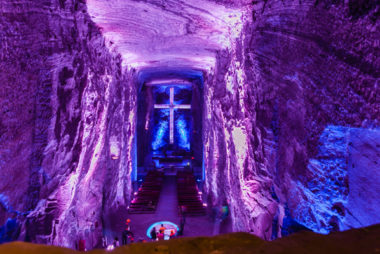
Zipaquirá’s halite mines have captivated imaginations for centuries. As far back as 2000 years ago, local tribes held the secret location of these precious mines, which played a vital role in their economy. During the Spanish colonial era, salt was as valuable as gold, and soldiers were often paid in the then-prized mineral. Intrigued by the tales of these legendary mines, the Spanish relentlessly pursued their discovery, ultimately unveiling the mines’ well-guarded location.
Visit the Salt Cathedral (the name is a misnomer: it is not a cathedral, but a live church), first and then proceed to the old town square in the centre of Zipaquirá for a well-earned lunch. Choose a restaurant with a view (ideally with a balcony that overlooks the square) and enjoy a Colombian meal.
The Town of Zipaquirá
In the town of Zipaquirá, if you stand on Parque Principal, facing the Cathedral, there is another interesting square just one block away. Turn left on the road just in front of the Cathedral (click on the URL for the map), walk across one block and you should be on the Plaza de la Independencia. It was created to celebrate Simón Bolívar’s liberation of the six Andean countries from the colonial power of Spain. You will find the flags of the countries he liberated, flying on the Square. There are more cafes and restaurants on Independence Square than on the main square.
As you explore Zipaquirá, immerse yourself in the stories of its past, from the pre-colonial days of indigenous tribes to the Spanish quest for gold and fortune. Relive the pages of history and create memories that will last a lifetime on this extraordinary day trip.
Return to Bogotá and your hotel in the afternoon. The trip requires the whole day. If you would like Coromandel SAS to handle your visit to Zipaquirá please use this link to read about the tour we offer and access our tour booking form.
Alternative 1: Visit the Andes Town of Guatavita
As an alternative to Zipaquirá, during your three days in the capital city, you can visit the town of Guatavita (click for details on a day trip), a picturesque destination approximately 90 minutes from Bogotá. When arranging your transportation, please ensure your driver is taking you to Guatavita the town and not to the Laguna de Guatavita. The new town of Guatavita, constructed in the colonial Spanish style of architecture, is the town’s main attraction.
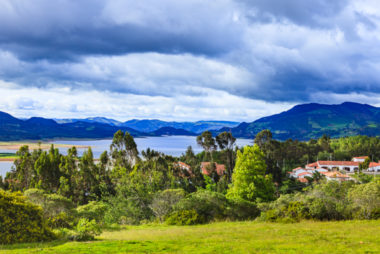
Guatavita is known for its scenic lakeside Andean beauty and the Tominé Reservoir. The much loved original old town of Guatavita, founded in 1593, now lies submerged at the bottom of the current lake. The residents of the old town were provided for in the new town that you see today. The reservoir was completed in 1967 as a hydroelectric project. Use this link if you would like Coromandel SAS to book the trip as a guided tour with transportation.
The main attractions in Guatavita are its squares and the small bullring (mainly a location for events not for bullfighting). After you have finished with the squares where you could sit outside one of the restaurants and enjoy the cool weather while having your lunch. You could then drive down to the lakeside of the Tominé Reservoir, for some splendid views of the lake and the Andes Mountains in the background, before your journey back to Bogotá.
Alternative 2: Sundays in Bogotá and the Mercado de las Pulgas
If your Day Three falls on a Sunday (or you can draw up your itinerary to make it your Day 3), you could spend a few hours at the Mercado de las Pulgas (Flea Market) in Usaquén. It happens every Sunday, right through the day. You may have to rearrange your itinerary to take in Plaza Usaquén. While planning your itinerary for Bogotá, please remember that the Gold Museum is closed on Mondays.
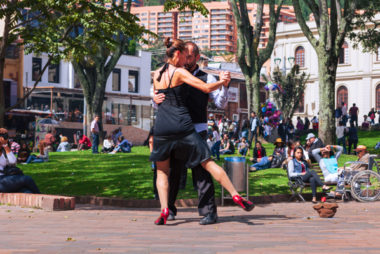
Explore this lively flea market in and around the historic Usaquén Square. Local vendors display a surprising variety of items for sale on the streets around the Square. Many streets are closed to vehicular traffic on the day. The Flea Market has the promise of being an amazing journey of discovery. Sample a delicious variety of Colombian food at one of the many restaurants in the area, enjoy live music on the streets, and perhaps even join in some impromptu dancing. You could spend hours at this unique flea market and take in part of Colombian life and culture. You will never be bored at this one-of-a-kind Mercado de las Pulgas.
Sunday is also the morning of the weekly Ciclovia. Bogotá has the proud reputation of the city that invented the weekly cycle day. It is the City’s gift to the world. Many cities in Latin America and around the world have now created similar cycles only days. Usaquén is on the route of the Ciclovia in Bogotá.
As You Pack For Your Visit to Colombia
You would be wise to pack a foldable umbrella in your baggage. Remember that Colombia is the rainiest country in the world. In Bogotá, it can rain right around the year, any time of the day or night. With temperatures hardly reaching a high of 20º C, most people would also need a jacket or a pullover to keep warm as well.
Visas – Everyone’s Important Question
Visas when you travel, are always the responsibility of the traveller. I would advise that you check with your nearest Colombian embassy to see if you need one. If you do, please check to see what information and documents need to be submitted along with your application.
Having mentioned that, please note that Colombia has a fairly extensive list of countries whose nationals do not need a visa to enter the Country. There is also a short list of countries whose nationals if they have a tourist visa for the USA, are allowed to enter Colombia without a visa.
For additional information click this link to the relevant page on the website of the Ministry of External Affairs. The final authority whether you need a visa or not rests with the Colombian Embassy or Consulate where you live.
Your Accommodation in Bogotá
Choose between a hotel or an Airbnb accommodation for your stay in Bogotá. Focus on staying in the northern part of the city for safer neighbourhoods. Consider a location between Calle 91 and Calle 127, close to the Eastern Mountains: between Carreras 7 and 19. If you choose to stay within walking distance of Parque de la 93, you will find the area around the park with plenty of activity. It is surrounded by restaurants and coffee shops. There is also a Juan Valdez outlet – a popular Colombian cafe, on the Square.
What to eat in Bogotá?
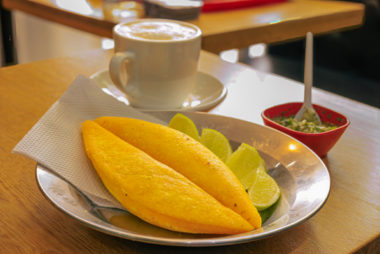
Colombian food is usually mild. Most food is non-vegetarian. You could try the Bandeja Paisa (a complete platter with rice, sausage, a lentil dish, fried banana, a slice of avocado, an arepa and a fried egg on top), Tamales (rice mixed with meats, packed in a banana leaf and steamed), Sudado de Pollo (rice, chicken, potato and a salad), fried trout (trucha), Arroz con Pollo (rice with chicken), or the well known Ajiaco (a Colombian soup with corn, meats and potato). They say you should not leave Colombia without tasting their Ajiaco. It is a complete meal on its own.
Empanadas are an anytime snack. It is a chicken or beef (often with rice as well), turnover in pastry or thick corn dough and either deep fried or baked. It is delicious.
How do you survive in Colombia if you are a vegetarian?
That can indeed be a challenge in a country where they eat so much meat. Colombia has a variety of breads. Pan de Queso – a bread with cheese mixed into the dough and baked. Pan de Yuca – usually shaped like a horseshoe: a bread made of tapioca/cassava flour. Almohábana – a cheese bread. Pan de bono – another cheese bread. Roscón de Arequipe – a circular bread stuffed with a little bit of Arequipe (reduced milk); it is sweet. Roscón de Bocadillo – a bread stuffed with a little bit of sweet guava paste. Mantecada – Colombian-style butter cornbread (also sweet). Most of the above are usually eaten as snacks with a good cup of Colombian coffee, or tea.
Vegetarians can also eat Cheese Empanadas (a snack), Patacones – fried plantains, and different varieties of potatoes (the Americas’ gift to the world), – I have never seen as many varieties of potatoes as I have seen in Colombia. Fresh salads or vegetarian pizzas are also available. Colombia serves a variety of lentils, but you should ensure it does not contain meat.
You could also check to see whether the restaurant has a vegetarian menu. They could indeed surprise you.
You will do well to learn the phrase: “Sin carne, sin pollo” in Spanish. Translated that would mean, “without meat or chicken.” Pollo is locally pronounced as, “Pojo” or “Poyo.” “Soy vegetariano (m)” pronounced “Soy vehetariano” – I am a vegetarian.
Colombia has a wide variety of fresh fruit available. The much-loved mango the world over is available in Colombia throughout the year. Juices from different fruit often accompany a meal they are served either mixed with water, or milk.
Travelling Within Bogotá City
Use the Tappsi Easy mobile app, to order secure and reliable taxis in Bogotá. Uber is also available. You can indeed use the public bus service. The various routes are available through Google Maps. It would however need a little more experience with the City’s roads to be able to recognise where exactly you are in the City! Unless you speak Spanish, local public transportation is not usually recommended for tourists.
Driving within Colombia and particularly Bogotá is not very easy. One will need to be prepared for some reckless and aggressive driving. I would advise that you use an alternative form of transportation.
Please note that the City’s streets are not adequately signed. We usually navigate our way around by using the house and building numbers. They are affixed on the front of every house or building.
Enjoy The Best Of Bogotá in 3 Days!
I hope I have enticed you to stay longer in Bogotá. You could then take on both the day trips mentioned above. That would require you to extend your trip by an additional day. Enjoy your visit to this lovely, interesting capital city of Colombia. Welcome to Bogotá – the gateway to South America!
Additional Links And Information
- Visiting photographer in Bogotá and the Sabana; safety and security – by Mano Chandra Dhas
- More information on the Andes capital city of Colombia. Source: Wikipedia
- Pre-Colombian history of Colombia. Source Wikipedia
- Read more about the one-of-a-kind Gold Museum. Source: Wikipedia
- The history of Plaza Bolívar dating back to the pre-Colombian era to the Muisca Confederation. Source: Wikipedia.
- More information on La Candelaria. Source: Wikipedia.
- Music and culture at Teatro Colón. Source Wikipedia.
- The Palacio San Carlos. Source Wikipedia.
- Where Bogotá was founded: The Chorro de Quevedo. Source Wikipedia.
- The inhabitants of the high plateau (the Altiplano Cundiboyacense) – the Muisca. Source Wikipedia.
- The mountain peak of Monserrate played an important role in the Muisca culture. Source Wikipedia.
Souvenir Photographs
You may wish to view some of my photographs of Bogotá and La Candelaria. They are available for sale. Prints and merchandise are available through my photography website: FotoVentura.co
Note
As mentioned, the above itinerary is mainly for the DIY enthusiast. For the adventurous who’d like to explore parts of this interesting capital city on their own. You would have to organise transportation and read up quite a bit on the Internet to go into further details. If you’d like to do tours the quick and easy way with qualified expert guides, Here is a link for an itinerary that covers a lot of what is mentioned in this post.
Information, Booking and Prices Enquiry
Coromandel SAS offers many different tours in and from several Colombian cities. Please use the form below to tell us what you would like to do in Colombia, and we can recommend a tour that you will love.
Note – Share your thoughts below. I will respond to all comments. Use the social media buttons to share this post with others who might find it useful. Please subscribe to never miss an update!
© Mano Chandra Dhas
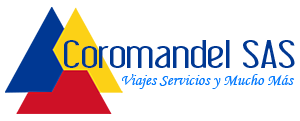
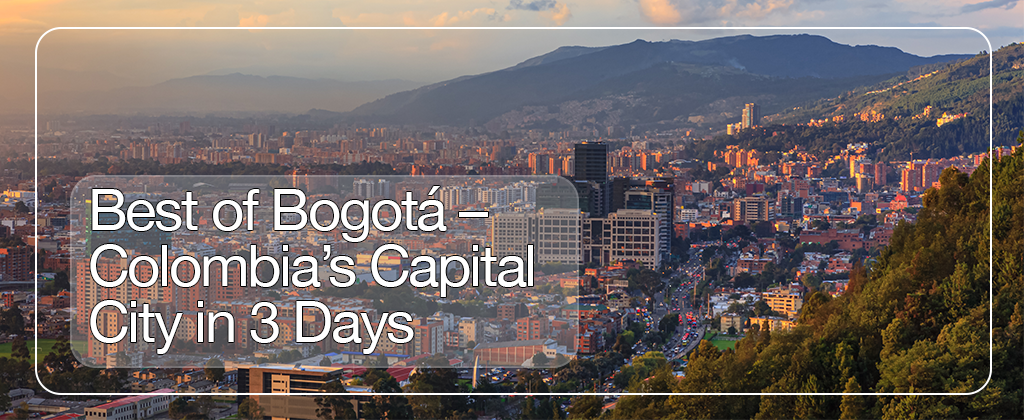
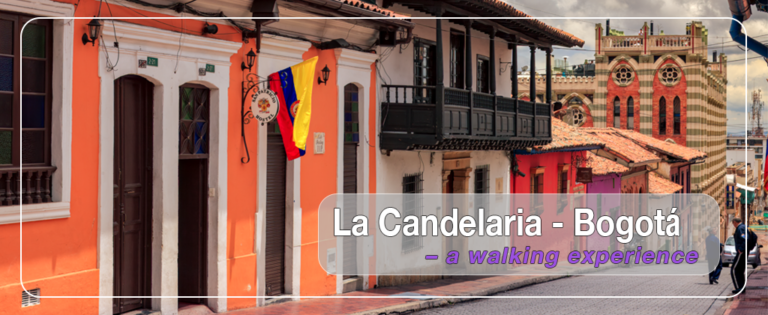
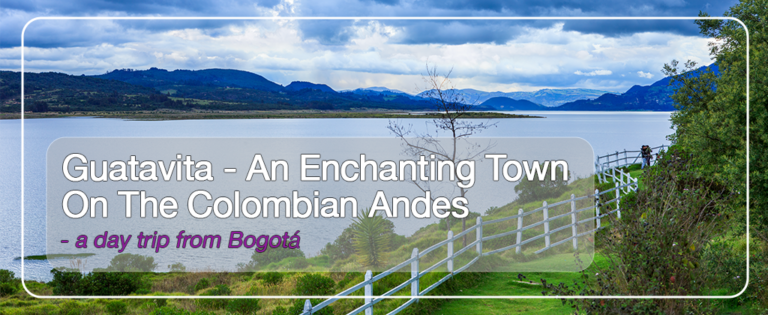
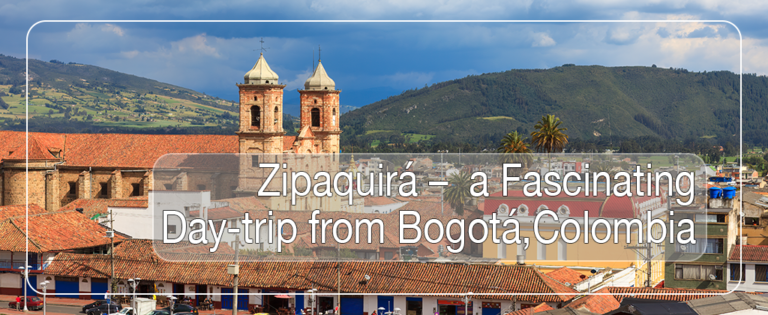
Mano, I cannot say it any better than the above comments by Sunitha and Sanath (my writing skills are not quite on par with theirs). Will look forward to my trip to Colombia.
P..S. Will also look forward to your possible visit to Seattle. Tex/Suresh
Thank you, Suresh, for your kind comment. I will also look forward to your visit to Colombia. It would be good to reconnect in person after almost 56 years! I have never been to the State of Washington even though I have been to the West several times and as far north as Oregon. Hopefully one day I will be able to visit. 🙂
A great detailed read as always Mano. Definitely on the bucket list now. 👍🏼
Thank you for your comment, Fahim.
Dear SIr
Thank you so much for giving us the insight of Colombia. I am sure for most of us it will be very very helpful.
Thank you!!!
Thank you for your message, Riyaz. I appreciate your comments.
Being a travel professional while Columbia has been part of my professional conversations especially during the football season; today I am more enriched with the knowledge of this beautiful country through your lens Mano-Very well scripted for many reasons; the cherry on top of the cake being your article was complete in all forms and great fodder for any traveler who would want to visit that place; not just that; your article also acts as a magnet to put Columbia as a very important part of South American travel itinerary. Thank you for the write-up Mano.
Thank you for your comments, Savio. There is currently not much available in English about Travel itineraries to Colombia. I wanted to do my part in setting that right. I started with Bogotá, where I have acted as a personal guide to friends (and friends of friends), who now seem to visit regularly – mainly from the USA. 🙂
⭐️⭐️⭐️⭐️⭐️
That’s was a well-written and informative read, encompassing all the items that one might have on their travel check-list and a few handy tips to further enhance a first time visitor’s experience.
Hi Sunita, I seem to have missed your comment. Thanks. A long time ago, infact several decades ago, I worked with Thomas Cook. Leisure and Tours were my speciality. Tanks again for your comment.
Very very interesting article! To someone who has not been to Bogota’, I crave to see the city now! Very picturesque description and details.
Thank you Sunita. I hope you will be able to visit some days soon!
👍👍👍👍👍👍👍
Excellent write-up.
Well-crafted with thoughtful salient points and exhaustive pertinent observations thrown in as required.
The appropriate photographs enhanced the experience as the reader got the feeling of ‘being there in person’.
Please keep up the good work.
Thank you, Sanath for your kind comments. Colombia is an interesting and lovely country; I have tried to convey a little of it through my article.